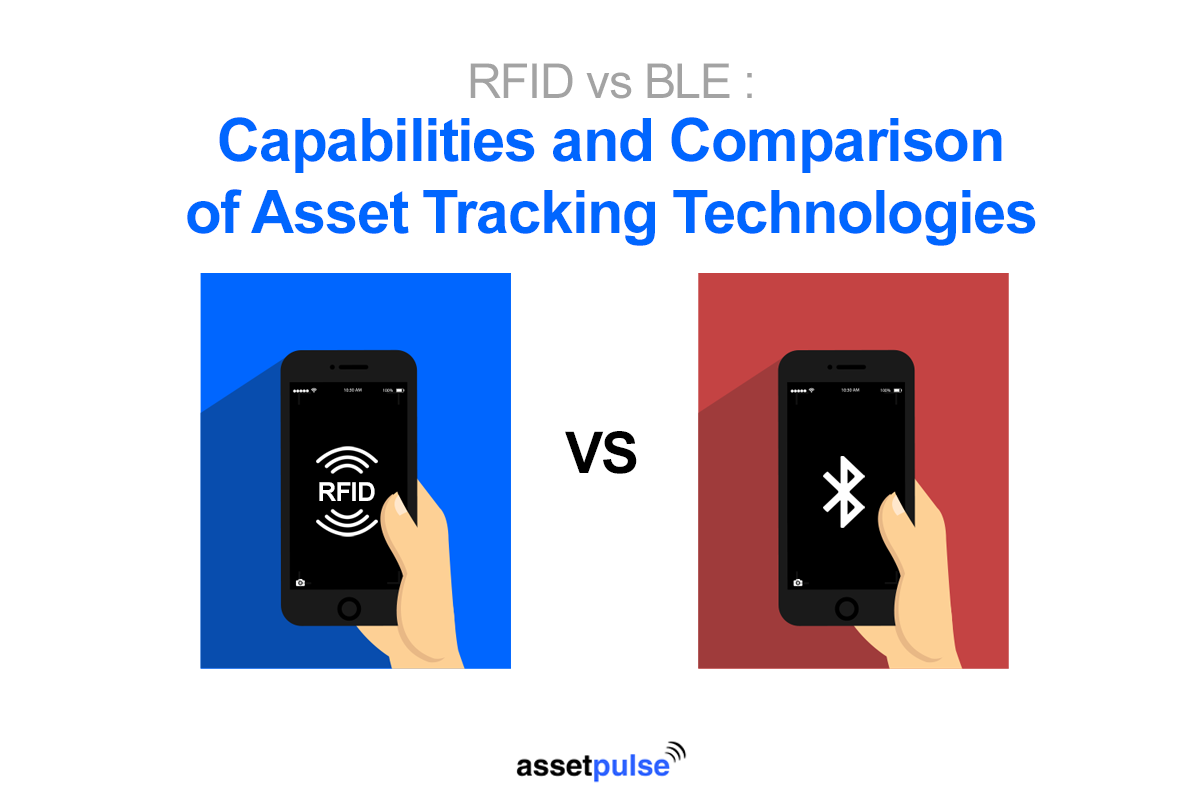RFID (Radio Frequency Identification) and BLE (Bluetooth Low Energy) are two distinct wireless communication technologies that are used for various applications. RFID is a passive technology that uses radio waves to transmit data between the reader and the tag. The tag is attached to an object and contains a unique identifier that can be read by the reader. BLE asset tracking, on the other hand, utilizes low energy Bluetooth for active, two-way communication between devices. This makes BLE ideal for applications requiring real-time location updates and data exchange, commonly seen in wearables and smart home devices.
Looking for RFID Asset Tracking Solutions?
Get Real-Time Visibility and Accurate Inventory with Best-in-Class Solutions
Explore Now!This blog post will help you to learn about the uses of RFID and BLE technology including RFID asset tracking and Bluetooth tracking, RFID vs BLE key differences and determine which technology is best suited for specific requirements.
Uses of RFID Technology
Inventory Management
RFID technology can be used to track assets and manage inventory in real-time. RFID tags are attached to assets and read by RFID readers to accurately track the location and status of assets in the labs, data centers, manufacturing facilities or warehouses. This enables businesses to have a better understanding of their inventory and avoid stock shortages or excess inventory.
Supply Chain Management
You can use RFID technology to track and manage raw materials and finished goods throughout the entire supply chain, from production to delivery. RFID tracking helps to track work orders and WIP at every stage of the manufacturing process and enables to track the movement of raw materials and products throughout the supply chain. This helps companies to streamline their supply chain process, identify and fix any bottlenecks and improve the overall efficiency and outcome.
Asset Tracking
RFID asset tracking can come in handy to track a wide range of assets including lab equipment, IT assets and tools. It helps businesses to quickly locate the assets for use, calibration and preventive maintenance. RFID helps businesses to complete inventory audits 10x faster, improve asset utilization and improve efficiency.
Lab Sample/Specimen Tracking
In addition to tracking lab equipment, RFID can also be used in tracking lab samples/specimens that are used in various clinical trials and tests. It helps to get visibility of lab samples through various stages of testing, eliminate diagnostic errors through accurate lab sample tracking, get real-time inventory and improve lab testing process.
Uses of BLE Technology
Wearables
BLE technology is used in wearable devices, such as smartwatches, fitness trackers, and smart glasses. BLE devices can be paired with smartphones or other devices to transmit data, such as fitness and health data, in real-time. This allows individuals to monitor their health and fitness levels and make more informed decisions about their lifestyle.
Smart Home Devices
BLE technology can be used in smart home devices, such as lighting systems, security systems, and smart thermostats. BLE devices when paired with smartphones or other devices are used to control and monitor the functionality of smart home devices from anywhere, at any time.
In-Store Navigation
BLE technology can be used in in-store navigation to help retailers to improve the shopping experience and increase sales. It helps customers find products and navigate the store. BLE beacons can be placed throughout the store and paired with a customer’s smartphone to provide real-time information and promotions based on their location in the store.
Healthcare
BLE technology enables healthcare providers to monitor their patients’ health and wellness, and make more informed decisions about their care. BLE devices, such as wearable health monitors, can be paired with smartphones or other devices to transmit health data, such as heart rate and sleep patterns, in real-time.
Industrial IoT
BLE technology helps businesses to increase the efficiency of their operations and reduce the risk of equipment failure. Bluetooth device tracking can be used in the Industrial Internet of Things (IIoT) to monitor and control industrial devices and systems. BLE devices can be paired with smartphones or other devices to monitor and control the functionality of industrial systems, such as production line machinery and HVAC systems.
Asset Tracking
BLE Technology can also be used for asset tracking purposes, as an alternate to RFID asset tracking. BLE asset tracking is typically used when assets are needed to be tracked in large open areas like open factory floors that may be more than 25,000 sqft in size or in large open yards, which might span several acres.
Comparison of RFID vs. BLE
Range
Since RFID tags don’t have a power source, they rely on RFID scanners to power them. The read distance of the average RFID tag is typically shorter than the read distance of the average BLE tag. There might be variances in specialized RFID and BLE tags, where the RFID tags may be readable at longer distances than Bluetooth tags.
Data Storage
RFID tags have a limited amount of data storage compared to BLE tags. RFID tags typically have a storage capacity of up to several kilobytes, while BLE tags can have storage capacities of up to several megabytes. Because of this, BLE is a better choice for applications such as wearables that require additional data storage.
Power Consumption
Since RFID tags have no power source, they rely on an RFID scanner in close proximity to power them. Batteries power BLE tags and hence have their own power source. Therefore, for applications that require the tag to be working continuously, like in wearable technology, BLE is the better option when compared to RFID.
Security
Both RFID and BLE technology have varying levels of security, depending on the implementation. RFID tags can be encrypted to prevent unauthorized access to the data, while BLE devices can use secure communication protocols to protect against hacking.
Interoperability
RFID and BLE technology can be designed to work with a wide range of other devices, depending on the implementation. RFID readers can be designed to work with multiple types of RFID tags, while BLE devices can be designed to work with other BLE devices and other Bluetooth-enabled devices.
Cost
The cost of RFID and BLE technology can vary greatly depending on the implementation and the specific requirements of the application. RFID tags are typically less expensive compared to BLE devices, but BLE devices offer more advanced features and functionality.
RFID vs. BLE: How to Choose the Right Technology
RFID and BLE technology each have their own strengths and weaknesses, and it’s important to understand the trade-offs between the two technologies. When choosing between BLE and RFID technology, it is important to consider the specific requirements of your application. Factors such as read range, data transmission speed, and cost should be taken into account to determine which technology is best suited for your needs.
The cost of RFID and BLE technology can vary greatly depending on the specific requirements of your application. It’s important to conduct a cost vs. benefit analysis to determine the total cost of ownership of each technology and determine which technology is the most cost-effective for your needs.
In conclusion, both technologies have a wide range of applications, from lab equipment tracking, inventory management, tool tracking, lab sample tracking, WIP tracking, and supply chain management to wearables, Bluetooth device tracking and smart home devices. Ultimately, the choice between RFID and BLE technology will come down to a trade-off between cost, performance, and application requirements.
Want Solutions to Maximize Efficiency?
Check out AssetPulse BLE Asset Tracking Solutions
Explore Today!FAQs
1. What are the primary use cases for RFID and BLE in asset tracking?
RFID is commonly used for real-time inventory management, lab sample tracking, lab equipment tracking, WIP tracking, work order tracking and supply chain operations where high-speed scanning of multiple assets is required. It’s ideal for environments like warehouses, labs, and manufacturing facilities. BLE excels in scenarios requiring continuous real-time updates and longer tracking ranges, such as tracking assets in large open areas, industrial IoT setups, and wearables in healthcare.
2. How does the cost of implementing RFID compare to BLE?
RFID tags are generally more affordable than BLE devices, but the total implementation cost depends on the infrastructure, such as the number of RFID readers or BLE beacons required. BLE devices often have higher upfront costs due to their active power source and advanced functionality.
3. Can RFID and BLE technologies be integrated into the same system?
Yes, hybrid systems can combine RFID and BLE to leverage the benefits of both. For instance, RFID can handle high-speed inventory audits, while BLE can monitor real-time movements in expansive areas. Such integrations are often used in advanced asset management solutions.
4. Which technology is better for environments with large open spaces?
BLE is more suitable for large open spaces like yards or factory floors exceeding 25,000 sq ft due to its extended range. RFID requires closer proximity between tags and readers, making it less ideal for vast areas unless paired with specialized RFID readers. Schedule a free consultation with our RFID/BLE experts.
5. Which technology is better for tracking assets moving through a ‘choke point’, doorway or gate?
RFID is better suited to track items moving through a relatively narrow pathway, like a doorway, corridor, aisle way or gate. They also would be the technology of choice to track assets in small enclosed areas like cabinets, shelves, refrigerators etc.
6. How do RFID and BLE differ in terms of maintenance?
RFID tags are passive and require minimal maintenance as they don’t have a power source. BLE devices, however, require periodic battery replacements or recharging, adding to their maintenance requirements.
7. What industries benefit most from RFID and BLE technologies?
RFID is widely used in industries like laboratories, IT, logistics, manufacturing, healthcare, and retail for inventory management and asset tracking.
BLE is preferred in industries like healthcare (wearables), retail (in-store navigation), and smart home solutions for its real-time data transmission capabilities.
8. How secure are RFID and BLE for data transmission?
Both technologies offer encryption and secure communication protocols, but BLE’s two-way communication allows for more advanced security measures like mutual authentication. RFID tags can be encrypted to safeguard data, but they rely on the security features of the readers.
9. Are there environmental factors that impact RFID or BLE performance?
RFID tags can be affected by materials like metal and liquids, which may interfere with radio wave transmission. BLE is less sensitive to such factors but may face signal interference in highly congested wireless environments.
10. Which technology is better for real-time location tracking?
BLE is better suited for real-time location tracking due to its active communication capabilities. RFID, while efficient for location updates, typically provides data only when scanned by a reader.
11. How do RFID and BLE differ in terms of scalability?
RFID systems are easier to scale for inventory management across multiple locations due to the affordability of tags. BLE systems, though more expensive, provide better scalability for applications requiring continuous monitoring over larger areas.
12. Can BLE technology replace RFID in all applications?
No, BLE cannot replace RFID in all applications. BLE is better suited for real-time tracking and applications requiring active communication, while RFID is more cost-effective and efficient for high-volume scanning and tracking in static or controlled environments.
13. What key factors should be considered when choosing between RFID and BLE?
The key factors include:
Range: BLE for long-range tracking, RFID for shorter distances.
Power Source: RFID is passive, while BLE requires a battery.
Cost: RFID tags are cheaper; BLE offers advanced features.
Use Case: RFID for bulk asset tracking; BLE for real-time updates.
Conducting a cost-benefit analysis is essential to determine the best fit for your application.


